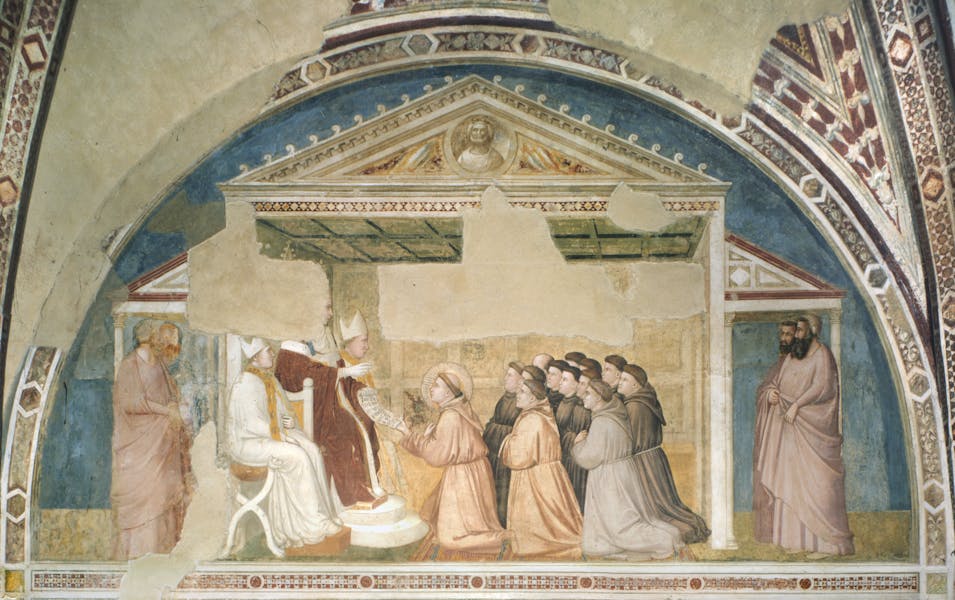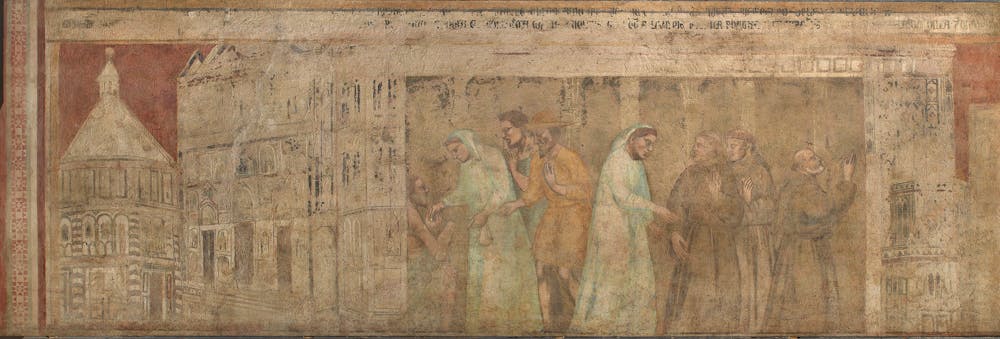
The Franciscans
The history of the Franciscans in Santa Croce from the origins to the present day
Francis and the Friars Minor
The first community of Friars Minor formed around the figure of Francis of Assisi (1181/1182–1226), the son of a wealthy cloth merchant. Francis spent his youth working in his father's business and dreaming of knighthood until a series of events in those early years triggered an existential crisis that helped him to understand his true calling: living in poverty among the poor, devoting his energies to the sick and the needy, earning his own keep, having no fixed abode and spreading, both by word and by example, the joy of a life forged on the model of Christ and His apostles.
Leaving his father's house, Francis began a new life with a small group of friends based on meditation on the Gospel and inspired by the values of humility, poverty and the happiness that comes from giving up worldly goods and wealth to embrace the world in a spirit of brotherhood.
Initially eyed with suspicion by the Church hierarchy, Francis's revolutionary life style and message were soon welcomed with enthusiasm not only by the poor and needy but also by the new social classes that were starting to form in those years: the craftsmen, merchants and other professional people who worked for a living and who saw in Francis's example a way to live their lives in a manner consistent with their Christian faith.
The obedience shown by Francis and his companions to the authority of the Church persuaded Pope Innocent III to approve their life style verbally and to permit them to preach repentance in 1210. The brothers promptly began to spread the new Franciscan message, even reaching out to areas distant from Christian society, and the success of their missionary activities prompted Pope Honorius III to welcome the brotherhood into the bosom of the Church by officially approving their Rule in 1223.
In the meantime, the Order's rapid development led to the construction of convents, to an influx of donations and to intellectuals joining the Order. These changes transformed the very nature of the community, distancing it from its founder's example based on living in poverty among the poor and needy and spreading the message of the Gospel, without clashing with the Church but also without establishing convents.

Giotto, Confirmation of the Franciscan Rule, scene from the Stories of the Life of St. Francis, c. 1317–21, fresco. Florence, Santa Croce, south transept, Bardi Chapel
The Franciscan Order in history
Francis's death on 4 October 1226 and his extremely rapid canonisation by Pope Gregory IX in 1228 initiated a long period marked by privileges, grants and reforms designed to tailor the Order to the ecclesiastical organisation of the day and to allow the friars to perform duties of a pastoral nature such as preaching, hearing confession and caring for people's spiritual needs.
One of the leading players in this reorganisation process was Bonaventure of Bagnoregio, Minister General from 1257 to 1274, who virtually refounded the Order in his determination to allay the tensions within it. The debate on poverty and on the life style that the Friars Minor should adopt, however, was soon reignited and led to a rift between those who wished to keep faith with the spirit of the Rule established by the founder (the Spirituals) and those who considered it necessary to tailor the Rule to the Order's new dimension and to the tasks assigned to it by Papacy (the Conventuals). Due to the radical nature of their positions which also attracted the hostility of the Church authorities, the Spirituals were gradually sidelined and eventually branded as heretics and hounded by the Papacy.
The Spirituals' legacy was revived around the middle of the 14th century by the Observant movement which, while arguing in favour of a stringent interpretation of the Rule, nevertheless remained loyal to ecclesiastical authority. The Observant community was joined by such great men as St. Bernardino of Siena who helped to establish its prestige and attract new members, but a splinter movement which became known as the Capuchins eventually developed in an effort to return to the life style formulated by the founder.
The original clash over the interpretation of the Rule, particularly with regard to the observance of absolute poverty, was to be a constant feature of the history of the Franciscans and explains the creation throughout the centuries of Minorite splinter groups ceaslessly reformed and merged by the Church authorities.
The Franciscan Order today
Today the word Franciscan is used to qualify religious founded or inspired by St. Francis of Assisi: the Friars Minor (First Order), the Poor Clares (Second Order, nuns, founded by St. Clare in 1212), and the Tertiaries (Third Order, comprising secular members who partake of Franciscan life and spirituality). Officially, the Franciscans are the Friars Minor, the religious in the First Order founded by St. Francis who chose the epithet "minor" as a mark of humility. The First Order is currently divided into three families, each with its own constitutions and characteristics resulting from a complex set of historical events:
- Friars Minor Observant (O.F.M.)
- Friars Minor Conventual (O.F.M. Conv.)
- Friars Minor Capuchin (O.F.M. Cap.)
The Franciscans are organised in Provinces, Custodies, missionary Foundations and Convents and are governed by a Minister General and by Provincial Ministers.

Pietro Nelli (attributed), The First Franciscans Come to Florence, late 14th century, Santa Croce, Museo dell'Opera
The Franciscans in Florence
St. Francis's followers first came to Florence in the winter of 1209. They were taken for beggars and thieves and got a pretty hostile reception, but they did not lose heart. They spent their first night in a porch outside the city gate of Porta Mugnone and were seen at dawn the next day praying devoutly in the cathedral. Refusing money and claiming to be poor by choice, they soon incurred people's esteem and affection, but after a while, much to the Florentine people's regret, they returned to Assisi.
In 1211 St. Francis came to Florence in person, tradition telling us that he stayed at the Ospizio di Santa Maria dei Magnoli (now Santa Lucia dei Magnoli). Francis was reportedly given a nearby chapel on a small island in the Arno dedicated to the Holy Cross, after which the church and convent of Santa Croce were subsequently named. Other ancient traditions credit the friars with temporary premises in the Pian di Ripoli area or on the banks of the Mugnone, near what is now the church of the Madonna della Tosse, before they settled where they are today. The first certain document, dated 14 September 1228, is a bull in which Pope Gregory IX takes the church of Santa Croce in Florence under his own personal protection and that of the Apostolic See.
The small church of 1228, traces of which were discovered when the floor of the basilica was repaired after the flood of 1966, must have been built by the Franciscans before that date, thus presumably in 1221.
The Franciscan Friars Minor Conventual have been in Santa Croce without a break since then.

